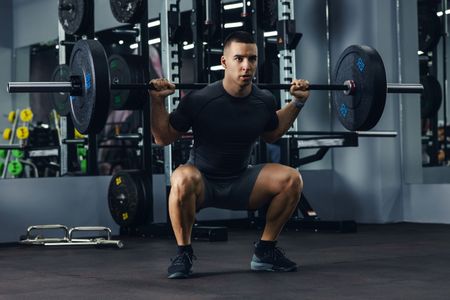A fitness wearable is an electronic device worn on the body that uses built-in sensors to measure various aspects of physical activity, health, and overall wellness.
Fitness wearables come in many forms—chest straps, wristbands, watches, rings, and even headbands. Most connect wirelessly to an app where you can see your data, often in real time.
Most wearables track steps, heart rate, sleep patterns, and calories burned. More advanced models also track heart rate variability (HRV), blood oxygen levels, skin temperature, stress levels, and even menstrual cycles.
The goal is to use this data to look for patterns that can help you overcome workout plateaus and improve physical performance, recovery, sleep habits, and your overall health and well-being.
How Do Wearable Devices Work?
Fitness wearables use sensors to measure various health metrics. Often, you can see these metrics in real-time right on the device. However, they also have wireless connectivity that sends this info to an app where you can access detailed reports, track trends, and make adjustments to your health stats and goals.
Typically, wearable devices use a combination of advanced sensors, each measuring a different health metric. For example, most wearables have an accelerometer that measures motion, speed, and direction to track steps, distance, and movement intensity, as well as a gyroscope to detect changes in orientation and position, helping track activities like cycling or yoga.
Modern wearables also might have an optical heart rate sensor, which uses light to measure changes in blood flow, estimating heart rate and sometimes heart rate variability (HRV). Some even have a GPS sensor that tracks location and distance.
More advanced devices also typically have an electrodermal activity (EDA) sensor to detect changes in skin conductivity to assess stress levels and a temperature sensor to monitor skin temperature, offering insights into changes in body function or overall wellness.
All of this data is then processed using complex algorithms that analyze movement patterns, heart rate fluctuations, and other physiological responses. This information is then sent to an app, where you can view detailed insights, set goals, and track progress over time.
How Wearables Enhance Your Fitness Experience
Are fitness wearables necessary to stay fit and healthy? Not at all! You can absolutely improve your fitness, track progress, and reach your goals without one.
However, wearables can be a powerful tool to enhance your journey. Studies show that fitness trackers, especially those that provide encouragement and feedback, can effectively increase physical activity, leading to significant health benefits.
But it goes beyond moving more and ensuring consistent intensity from workout to workout. Fitness technology can also provide valuable health metrics like sleep and recovery, which also affect your performance and overall health.
Here are a few key ways that fitness wearables can enhance your workouts and improve overall health:
Real-Time Tracking
Most wearable devices monitor various physical activities in real time– such as steps taken and daily movement.
Many will even send you notifications letting you know you’ve been sitting a little too long and need to get up and move. This immediate feedback provides valuable information that helps you assess your daily activity levels and make necessary adjustments to meet your fitness goals.
Some also show you how many calories you’ve burned. This can be helpful to track trends, but in most cases, you should not rely on the calories-burned statistics to make alterations in your physical activity or calorie intake (more on this a little further down.)
Personalized Health Monitoring
Modern wearables continuously track vital signs, including heart rate, heart rate variability (HRV), blood oxygen levels, body temperature, sleep patterns, and, in some cases, daytime stress levels.
This continuous monitoring provides you with real-time, and sometimes critical, data about your health, possibly even providing early detection of potential health issues.
Many wearable users report that their device told them they were getting sick days before symptoms showed up!
Motivation Through Goal Setting and Feedback
Let’s say you have a goal to hit 10,000 steps a day. Without a wearable, you’re guessing– and most people drastically overestimate how active they really are, especially when it comes to something like step count.
With a wearable, you can check your progress throughout the day and adjust as needed. For example, if you glance at your watch at noon and see you’ve only logged 1,000 steps, that number can give you the push you need to move more, ensuring you are on track to reach your goal by day’s end.
Whether it’s step goals, active minutes, or completing a set number of workouts each week, having a specific target and seeing where you stand makes it easier to stay consistent.
But it’s not just about real-time feedback. Wearables also show trends over time, helping you see how far you’ve come or where you need to improve, which keeps you accountable.
Many devices take it a step further by celebrating milestones, sending reminders, and encouraging you to maintain streaks. Even small wins add up, keeping you focused and more likely to stick with your fitness routine.
Sleep Awareness and Enhanced Sleep Quality
The sleep data collected by a quality fitness wearable is reason enough for anyone to consider investing in one. Far too many people overlook the importance of not only getting enough sleep but ensuring the sleep they do get is actually restorative.
You might have a general idea of how long you were in bed and how many times you woke up throughout the night, but without a wearable, you have no way to know your sleep quality, such as whether or not you are getting enough REM and deep sleep which are the phases most responsible for mental and physical restoration.
Most wearables track much more than sleep duration. They offer advanced sleep tracking that analyzes not just how long you sleep but how well. For example, you might think you’re getting a solid 7-8 hours, but without a wearable, you have no idea if you’re actually spending enough time in REM or deep sleep.
On the flip side, let’s say you only clocked 5 hours of sleep. You might assume you’re doomed for a sluggish day. But if your wearable shows that those 5 hours included enough high-quality sleep, your readiness to tackle the day might still be decent, even if the duration wasn’t ideal.
Quality sleep is just as important as exercise and nutrition in your fitness journey.
Sleep plays a critical role in cognitive function, emotional stability, muscle recovery, and even weight management. Fitness wearables are great for tracking all aspects of sleep, helping you identify patterns and make informed adjustments to your sleep routine.
For more on the importance of rest, read “The Importance of Rest Days: Balancing Exercise and Recovery.”
Prevention and Management of Health Conditions
If you have a chronic condition like heart disease or diabetes, wearables can provide valuable insights into key health metrics. Even for those without chronic conditions, these features can still be beneficial.
For example, wearable devices integrated with continuous glucose monitoring systems can send immediate alerts for abnormal glucose levels. They can also notify you if your resting heart rate is too high or low, track patterns in your heart rate variability (HRV), and measure blood oxygen levels. This data is incredibly useful for anyone managing heart health or anyone looking to monitor their cardiovascular health.
While wearables aren’t a substitute for professional medical care, they can act as an early warning system, helping you stay ahead of potential health issues.
Community Engagement and Social Support
Some wearable devices offer features that connect you with friends, family, or other like-minded people through progress sharing and even fitness challenges. This can help foster a sense of accountability and support that enhances motivation and helps make your fitness journey more enjoyable.
How To Integrate Wearable Data Into Your Fitness Plan
Wearables can be a valuable tool for improving your overall health and fitness journey, but it’s important to use the data they provide as a guide, not an absolute measure.
Fitness technology should complement your fitness plan, not dictate it. Here are a few ways to integrate your wearable to help you stay on track and make smarter choices.
1: Track Consistency, Not Perfection
Rather than obsessing over daily fluctuations in data like steps or calories burned, focus on trends over time. Look at your weekly or monthly data to see if you’re consistently hitting your activity goals or if there are areas where you’re falling short.
For example, if your step count gradually increases week over week, it shows you’re making progress. Consistency, not perfection, is the real key to achieving your fitness goals.
2: Adjust Workouts Based on Recovery Data
Pay attention to your heart rate variability (HRV) and resting heart rate data. A higher HRV and lower resting heart rate typically indicate good recovery and readiness for more intense workouts.
If your wearables show a trend of high resting heart rate or low HRV, it may be a sign that you need to back off a bit, prioritize recovery, or modify your training to avoid overtraining.
3: Use Sleep Data to Improve Sleep Health and Performance
Quality sleep plays a significant role in recovery and overall health. Your wearable can provide valuable insights that can help you assess the timing of your sleep, how long it takes you to fall asleep, and the quality of your rest, including how much time you’re spending in light, REM, and deep sleep.
If your wearable shows that you’re not getting enough restorative sleep, consider adjusting your evening routine—cutting down on screen time, practicing relaxation techniques, or tweaking your sleep environment.
Also, if your wearable provides this information, pay attention to irregularities in your breathing and blood oxygen levels as well; these could signal that your breathing is being interrupted during sleep, which may impact both the quality of your rest and overall health.
4: Stay on Top of Your Heart Health
The heart sensors on wearables do more than ensure you’re working within your target heart rate zone during cardio workouts. They can also help you monitor any potential issues related to heart health.
Heart rate and heart rate variability (HRV) are key metrics that can help you assess your cardiovascular health. If your wearable shows significant irregularities, it’s time to consult with a healthcare professional.
5: Don’t Rely on Wearable Data for Calories
While wearables can estimate calories burned, it’s important not to use these numbers as gospel. Most wearables rely on algorithms that use factors like heart rate, movement, and basic demographics (age, weight) to estimate calories burned, but they don’t account for individual factors like muscle mass, metabolic rate, or exercise intensity.
This means the number of calories burned shown on your device is an approximation, not a precise measurement. Instead, use the data as a reference point for how active you are rather than an exact guide to your caloric needs.
6: Set Achievable Goals and Track Progress
Your wearable can help you track how close you are to hitting your goals, potentially giving you an extra push to keep going.
Use the data collected from your wearable to create realistic, achievable goals and track your progress toward them. Whether you’re aiming to walk 10,000 steps a day, hit a specific number of active minutes per week, or improve your cardio performance, setting small, measurable targets can keep you motivated.
Top Fitness Apps for Tracking Progress
Some wearables and exercise equipment, like the Apple Watch, Fitbit, Oura Ring, and Peloton, come with their own compatible apps for tracking progress. Many of these devices can also sync with third-party fitness apps, although some are more integrated than others.
There are plenty of popular fitness apps available, including MyFitnessPal for tracking macros, Nike Training Club, Aptiv, Ladder, and Sweat for workout programs, Runna for running, Alo Moves for yoga, and Calm for mindfulness and stress reduction.
However, the best fitness app for you may not be the same as it is for someone else. It depends on the type of activity you want to track, your fitness goals, the health metrics that matter most to you, and even the wearable you’ve chosen.
Instead of listing the top apps favored by tech experts or the fitness community, here are a few tips for helping you choose the right app for your personal fitness journey.
Here are some things to consider:
- Your fitness goals: Are you looking to lose weight, build muscle, improve your running speed, or simply stay active?
- Your workout preferences: Do you prefer to workout at home, in the gym, or outdoors?
- If you need extra motivation or support: If staying motivated is a challenge, consider apps that have built-in features like reminders, challenges, rewards, or social sharing to keep you engaged and excited about your progress. If you could benefit from expert advice and support, some apps also have advisors where you can check in and ask questions.
- Reviews and features: See what other users are saying about different apps and compare their features to see which one best suits your needs.
- App Compatibility: Make sure the app works well with your device (phone, tablet, or smartwatch). Some apps might have better functionality on certain platforms or may not be available on all devices.
- Upfront Cost and Subscription Options: Some wearables only provide limited data unless you sign up for the paid version of their accompanying app. Sometimes, these fees are one-time, while others require a monthly subscription.
For other third-party apps you might want to use for tracking, check to see if the app offers enough value to justify its cost or if there are budget-friendly alternatives that meet your needs. Many of these apps offer free trials or free versions, so you can test them out before committing to a subscription.
Future Trends in Fitness Technology
Fitness technology started with basic pedometers that tracked steps and little else. Then came fitness bands and smartwatches, which added features like heart rate monitoring, GPS tracking, and sleep data. Not long after, smart rings entered the market, offering even more discreet ways to track health data.
So, what can we expect next? Not sure we’ll see many more “types” of devices—there are only so many places you can wear them—but what’s coming is a wave of cutting-edge technology that will make these devices more innovative, more intuitive, and even more valuable.
Here’s a closer look at some future trends you might see in wearable technology:
Smarter and More Advanced
Wearables have already moved far beyond counting steps and heart rate. They now track valuable insights into heart rate variability, oxygen saturation, sleep cycles, stress levels, and even hydration. There isn’t much more basic data available to track in the traditional sense.
However, with AI technology and machine learning advancing rapidly, you can likely expect wearables to provide even deeper, more personalized insights into your health, fitness, and recovery. These devices will likely become smarter at predicting potential issues and offering tailored recommendations.
Holistic Wellness with Mind-Body Integration
Thankfully, people are finally catching on to the fact that fitness isn’t just about physical strength. There’s a growing emphasis on mental and emotional well-being.
Many wearables already use technology to monitor things like stress, and we expect to see more of this. That means you can probably expect to see more programs that incorporate mindfulness, breathing exercises, and stress management techniques.
Immersive and Gamified Fitness
Gamified workouts integrate gaming elements like points, badges, and leaderboards into fitness routines to make exercise more engaging and motivating. Some apps and wearables even take it a step further, offering an interactive experience through virtual reality (VR) and augmented reality (AR).
These technologies are already changing how some people approach fitness, making it more immersive and fun. For example, platforms like Supernatural and FitXR immerse users in virtual environments where exercise feels like an interactive game. There are also apps like Kemtai and Mirror that use AR to provide real-time instructions and feedback on your surroundings, making at-home workouts more dynamic and engaging.
As these technologies continue to evolve, you can likely expect even more advanced integrations, such as AI-powered avatars or virtual personal trainers, offering real-time feedback in fully personalized VR fitness worlds.
Future gaming advancements could include multiplayer virtual competitions, where fitness communities train together in shared digital spaces, or real-world fitness games that seamlessly blend physical activity and gaming.
Hydration Tracking
Currently, most smart devices can only estimate hydration status by user input. From there, they don’t really do much other than give you a visual cue of how much water you’ve consumed and maybe send you a notification reminding you to take a sip of water.
However, we are seeing some fitness wearables introduce hydration sensors or perspiration measuring capabilities, so expect these tools to become more common in the future, as people start to understand the science of hydration and just how important staying hydrated is for good health.
FAQs About Health and Fitness Apps and Trackers
Should I Be Concerned About Privacy?
Most wearables collect sensitive information, such as your heart rate, sleep patterns, and physical activity. Some even track location data. This data is typically synced with an app or cloud service, where it can be stored and analyzed.
Many companies have security measures in place, such as encryption and data anonymization, to protect user data. However, breaches do happen, and the risk is higher if personal information, like your name, address, or health history, is linked to your device.
How Can I Ensure My Tech Wearable is Secure?
While most fitness wearables are secure, it’s important to be proactive in managing your privacy settings and ensuring you’re comfortable with how your data is handled.
To safeguard your privacy, first and foremost, it may seem unnecessary, but you should always check the privacy policy to fully understand what data is collected and how it’s being used and shared.
From there, take a look at the app’s privacy settings. Most apps allow you to adjust these. Everyone’s comfort level is different, but if you are concerned about privacy, you might want to limit what is shared with third-party apps and location services.
Also, if the app is password protected, don’t forget to use a strong password and set up two-factor authentication, if available, to add an extra layer of security. Updating software regularly can also help ensure the latest security features are in place.
Are Fitness Trackers Accurate?
Wearable fitness trackers have come a long way in terms of sophistication, but accuracy can still be hit or miss, depending on what’s measured. While step counting and resting heart rate are generally quite reliable, other metrics—like total calories burned and heart rate during high-intensity workouts—can be less precise.
For example, wearables that use optical sensors on the wrist work well during periods of rest or steady activity but tend to be less accurate during high-intensity interval training (HIIT) or strength training, where rapid changes in heart rate occur. For the most accurate heart rate readings, chest strap monitors are still the gold standard. We will discuss “calories burned” in the next frequently asked question.
Even though wearables may not be 100% accurate, they can still be incredibly valuable for tracking trends. The key is to focus on consistency and comparing your own data over time to help you identify progress and establish healthy habits.
Should I Trust the “Calories Burned” Number on My Wearable to Guide My Nutrition Choices and Daily Calorie Intake?
The calorie burn estimate on most wearables is one of the least accurate features. It shouldn’t be something you use to determine how many calories you’ve burned in a workout or day, and certainly not be used to calculate how many calories you should eat to reach your fitness goals.
Devices rely on algorithms that factor in heart rate, age, weight, and activity type, but they don’t account for individual variations in metabolism, muscle mass, or intensity. As a result, these estimates can be off by at least 20-30% (probably much more), leading to over- or underestimations of calories burned.
That said, it can still be a helpful tool. Even though the calorie burn estimate on most wearables isn’t accurate enough to determine how many calories you should eat or how many you’ve burned in a day, you can still use it as a benchmark for consistency.
For example, if your wearable shows that you burned 500 calories during cardio today and 600 doing the exact same activity last week, the difference can give you a sense of how your effort, intensity, or duration changed.
Can I Use a Fitness Tracker Without a Phone?
It depends on the wearable, but generally, you can use a fitness tracker without a phone, but the functionality might be limited.
Many wearables allow you to track basic metrics like steps, heart rate, and sleep directly on the device itself. However, for more detailed analysis and syncing data, you’ll need to connect the device to a phone or computer via an app.
Additionally, without a phone and accompanying app, features like real-time GPS tracking, notifications, and syncing historical data won’t be available until you connect the device again. Some devices may have built-in storage for data and can sync when you reconnect, but many still rely on a phone for a better experience.
Do Fitness Wearables Have Any Cons?
Aside from the accuracy limitations already mentioned, the only other things that might be considered “cons” would be cost and fixation.
While there are some budget-friendly wearables, most high-quality wearables with all the bells and whistles and advanced features can be a bit expensive. In addition to the upfront cost of the wearable itself, some devices also require monthly “memberships” to access all of your data.
Another con is that some people can over-focus on data and become obsessive over the numbers, which can lead to stress or anxiety about meeting daily goals. It’s important to remember that fitness is about progress and consistency, not perfection.
Conclusion
While fitness technology certainly isn’t required to achieve your goals, studies show that consistently using these devices and apps can significantly enhance your results, offering valuable insights and motivation along the way.
That said, even the best tech can’t replace the human element.
For many, having that extra push is crucial—whether it’s joining a gym that fosters a supportive, motivating community or hiring a personal trainer who can personalize your routine and keep you accountable. Both help you stay on track, push past plateaus, and maximize your fitness journey.
At Raw Athletic Club, we offer just that. We’re more than just a gym. Our facilities in Port St. Lucie and Stuart, FL, are fitness destinations that offer expert personal training, a motivating community, and a state-of-the-art environment designed to push you further.
Whether you’re striving to build strength, improve endurance, or enhance overall wellness, we give you the tools, support, and accountability to achieve real results. Click here to book a tour or contact us for more information on becoming a part of our gym community.



